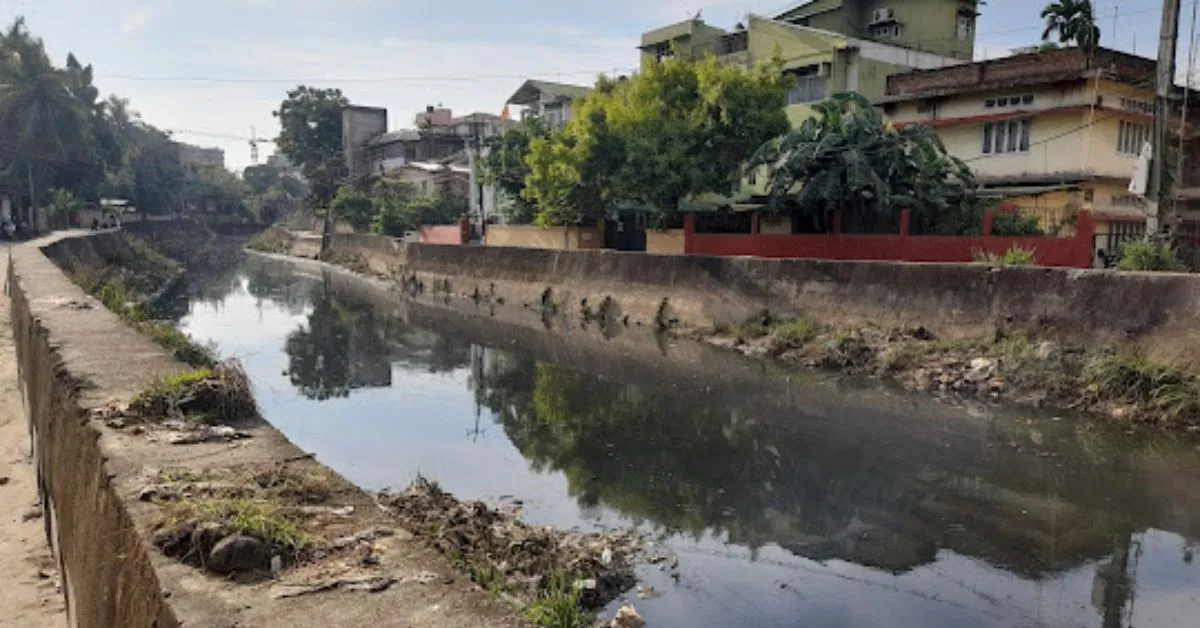
Solid waste disposal is another major issue. The river is choked with plastic, household waste, and other debris, which not only pollutes the water but also contributes to frequent flooding in the city during the monsoon season. The lack of public awareness and inadequate government intervention have allowed these practices to continue unchecked
The Bharalu River, once a vital waterway flowing through Guwahati, Assam, has tragically transformed from a natural river into a heavily polluted drain over the years. This article explores the multifaceted reasons behind this environmental degradation, the impact on the local community, and potential solutions.
Historically, the Bharalu River was an essential tributary of the Brahmaputra River, serving as a water source and a natural drainage system for the city. However, rapid urbanisation and poor waste management have led to its severe contamination. Today, the river is notorious for being one of the most polluted in the region, largely due to the unchecked disposal of sewage, industrial waste, and solid rubbish directly into its waters.
The pollution levels in the Bharalu are alarming. Studies have shown extremely high levels of Biological Oxygen Demand (BOD), indicating that the water is severely oxygen-depleted and unable to support aquatic life. The river’s contamination has reached a point where it poses significant health risks to the local population, particularly those living in the river's vicinity.
The primary cause of the Bharalu’s degradation is the rapid and unplanned urbanisation of Guwahati. As the city expanded, the infrastructure for waste management did not keep pace, leading to the river becoming a dumping ground for untreated sewage and industrial effluents. Moreover, rampant encroachment along the riverbanks has further exacerbated the problem, restricting the river’s natural flow and reducing its ability to cleanse itself.
Solid waste disposal is another major issue. The river is choked with plastic, household waste, and other debris, which not only pollutes the water but also contributes to frequent flooding in the city during the monsoon season. The lack of public awareness and inadequate government intervention have allowed these practices to continue unchecked.
The environmental impact of the Bharalu’s pollution is severe. The river, which once supported a variety of aquatic life, is now nearly devoid of fish and other organisms. The high levels of toxic substances in the water have also contaminated the groundwater, posing a serious health risk to the local population who rely on it for drinking water.
Health issues such as waterborne diseases, skin infections, and gastrointestinal problems are prevalent among communities living near the river. The polluted river also contributes to the overall environmental degradation of the region, affecting agriculture, biodiversity, and the quality of life in Guwahati.
Despite the grim situation, there have been efforts to address the pollution of the Bharalu. Various government agencies have proposed initiatives to clean the river, such as the Bharalu River Restoration Project, which aims to treat sewage before it enters the river and remove solid waste from its banks. However, these efforts have been hampered by a lack of funding, bureaucratic delays, and insufficient public engagement.
For a lasting solution, a multi-pronged approach is necessary. This includes improving the city’s waste management infrastructure, enforcing strict regulations against industrial pollution, and raising public awareness about the importance of keeping the river clean. Additionally, community-led initiatives, such as river clean-up drives and the restoration of natural wetlands, can play a crucial role in reviving the Bharalu.
The Bharalu River’s transformation from a lifeline to a liability for Guwahati is a stark reminder of the consequences of neglecting our natural resources. While the challenges are significant, a concerted effort by the government, local communities, and environmental organisations can restore the river to its former glory. The revival of the Bharalu is not just about cleaning a river; it is about reclaiming the health and well-being of the entire region.
ALSO READ | Bharalu: Tale Of A Dying River
The Story Mug is a Guwahati-based Blogzine. Here, we believe in doing stories beyond the normal.